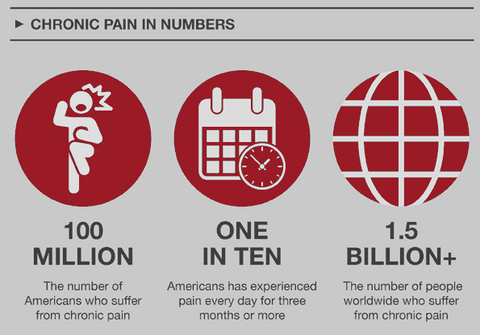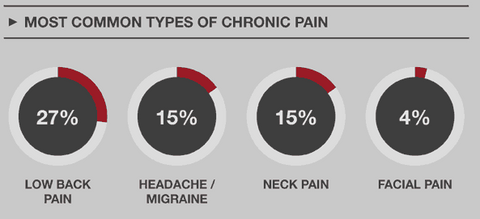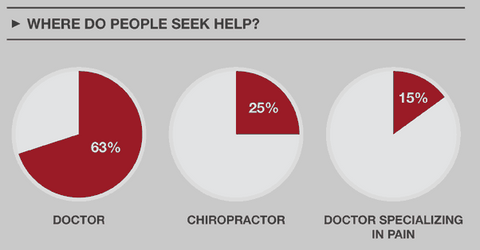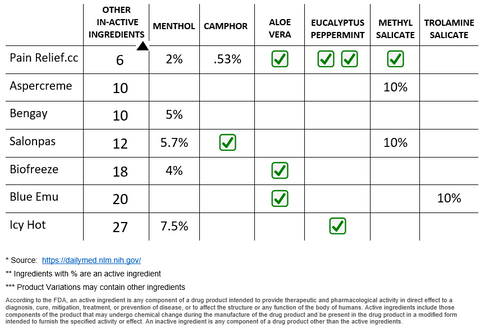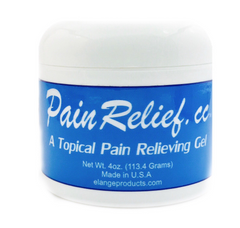The Road to Pain Relief.
Although pain affects more than 76 million Americans, it can be an isolating experience. According to the American Pain Foundation, pain is a critical, biological warning sign to the body when something. Pain can signal injury, such as touching a hot oven, or an underlying disease or infection, such as cancer or shingles. Pain is classified as acute or chronic. Acute pain usually follows surgery or injury and resolves as the body heals itself. Pain is diagnosed as chronic when it persists after healing has taken place.
Failure to treat acute pain promptly and appropriately can contribute to the development of chronic pain syndromes. In such cases, pain signals remain active in the nervous system for weeks, months or even years. In addition, pain can lead to other health problems, causing damage to the body. If untreated, chronic pain can weaken the immune system, decrease the quality of life, create feelings of anger and depression, lead to a deterioration of relationships, and result in a loss of independence.
Many people wrongly assume they have to live with pain - that it is an inevitable part of their disease or condition, or a natural part of growing older. The fact is most pain can be relieved with proper pain management.
Pain should be assessed thoroughly and treated early and aggressively. Early treatment is the best way to minimize the suffering and disability often associated with under-treated pain.
It's important to become your own best advocate as you navigate the road to pain relief and reclaim your life. The earlier you seek treatment, the better. Following are some helpful things to keep in mind from the American Pain Foundation:
In the search for a healthcare provider who will help you reach your goals of pain relief and management, you may have been told, "Nothing more can be done to ease your pain," or "You'll just have to live with it." If this is your situation, take the time to find a healthcare provider who has the education, skills and willingness to work with you to manage pain. Don't be afraid to speak up. Only you know the extent of your pain and how it affects your quality of life.
Consider starting a pain notebook, a tool to help you keep a record of pain. The notebook should include when the pain occurs, for how long, the level of pain, and its impact on day-to-day life. Keeping track of what things make your pain better or worse will help your healthcare team find the best ways to treat pain.
Knowledge is power. There are a variety of drug and non-drug therapies (e.g., physical therapy, yoga, meditation) available to effectively control pain. These are typically used in combination. Ask your healthcare provider about ways to relax and cope with pain. Pain can feel worse if you are stressed, depressed or anxious. Be an informed consumer and learn all you can about pain and pain management options.
As you work with your healthcare provider, set realistic goals for things you most want to do. Do you want to achieve better sleep? Begin exercising or return work? Begin with the easiest goals first. Set realistic goals for pain relief. Persistent pain tends not to disappear. Look for a provider who will work with you to get you to the point where you can "live life again."
Prior to appointments, write down questions you have and let your provider know if there is something you don't understand. Also, bring along a relative or close friend to provide support and to help take notes and remember what was said. Sometimes, it's easy to forget or misunderstand what was explained during doctor's appointments. Having someone else there to process the information can be a great boost to your appointments.
During initial appointments, share with your provider what over-the-counter medications, vitamins and supplements you take, at what does and how often. Also, be honest about personal health habits, such as smoking, alcohol use, etc., which can interfere with some pain treatments and increase pain levels.
Finally, find out about support groups and educational programs in your area or online. Also seek the support and encouragement of friends and family members when you need them. They can provide the incentive you need to not give up in your quest for pain relief. And remember, there will be both good and bad days. Give yourself some grace as you traverse the road to pain relief.
Now available for home use are pain relief creams to soothe the aches and pains associated with arthritis, psoriasis, tired joints and sore muscles from an active lifestyle. Thousands have benefited from the pain relieving power of these safe, natural, non-prescription treatments.

All-Natural Topical Pain Relief
Whether you have been physically straining yourself for work, at the gym or at play, or if you've suddenly engaged in some intense physical activities then it is highly likely that you will end up with sore muscles at different parts of your body. Of course muscle pain not only leaves you uncomfortable but it also hinders you from attending to your normal activities. Sure oral and topical pain relievers are very common but it doesn't mean that these are the best options around.
Topical pain relief that is derived from all-natural essential oils are not only known as effective but it's also very safe to use even by children. Whether it's joint aches, back aches, neck pain, sprains and other injuries, all-natural essential oils serve as wonderful alternatives to the more common creams that are being used for topical pain relief.
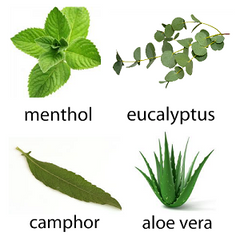
All-natural essential oils are absolutely safe as these are liquids that have been derived from plants. As these oils come in a more concentrated form compared to common medicines, these essentials oils are believed to be far more effective, and again safe.
So what are the all-natural essential oils that you should look for when it comes to topical pain relief? If you are suffering from physical pain, you should check out essential oils made from black pepper, marjoram, and basil to heal the soreness of your muscles while wintergreen and birch warms the muscles and is a great essential oil for injuries caused by exercises that have gone wrong. But what if you are looking for is something that will give you a cooling sensation to ease the soreness of your muscles then what you should get is peppermint. This essential oil can easily soothe muscle pain and tension.
While some of these all-natural essential oils can be easily bought from the pharmacy along with the normal medicine, you can also get bottles of these from all-natural health shops or through the internet. Depending on the rarity of the essential oil that you wish to buy, these are generally very affordable giving you more reason to opt to go herbal rather than stick to unnatural medicines for pain relief. And, these essential oils are also very easy to use and offer almost instant pain relief. Its soothing aroma will also help calm down your system and put you more at ease. Compare Pain Relief Cream here: [INGREDIENTS FACT SHEET]
But before you start shopping for all-natural essential oils, it is always best to do your fair share of research so that you will be able to learn more about the benefits of each essential oil as well. This way, whenever you are feeling out of tune or someone from your family is experiencing body pain, you will know which kind of essential oil will suit your/their condition best. It might also be a practical choice to stock up on the different essential oils at home so that you will have something to use whenever the need arises. Given that these are all-natural products, these are all very safe to use by just about anyone.
Topical Pain Cream for Joint Pain
Joint pain is a very common form of pain in the body that occurs in the area where bones meet and can be caused by many different reasons. This type of pain can result from a range of causes such as injury to ligaments and tendons to more serious conditions that are characterized by chronic inflammation in the joints. Some of the most common causes of this include: arthritis, an inflammation of the joints; osteoarthritis, a degenerative inflammation of the joints; rheumatoid arthritis, an autoimmune disease where the body's immune system mistakes its own cells in the joints for bad cells and attacks the area; sprains and strains; tendinitis; aches and pains associated with colds and flu; fibromyalgia, a chronic disorder that is characterized by widespread muscle and joint pain; bursitis, a condition where fluid sacs around joints are inflamed; and gout.
The pain in each of these situations can range in severity as well as duration. Some of it is acute and temporary and in other conditions and disorders, it is is chronic. The remedies to reducing the pain are varied in each instance. There are prescription medications for more severe pain, including muscle relaxants and antidepressants, as well as over-the-counter medications for milder pain which include the anti-inflammatory drugs ibuprofen and acetaminophen, just to name a few. Additionally, joint relief can also be a result from the use of topical creams.
Topical lotions can assist alleviate pain from arthritis and other ailments by lowering the pain, inflammation and distress to the affected place. Ingredients within some topical creams can also help transmit pain signals, thus triggering the release of natural endorphins within the body that block pain. Topical creams can offer a more appealing alternative to medications, which can often have adverse side effects for some people.
A prescription grade topical pain reliever will require a consultation with your personal General Practitioner. Normally they will Examination the joint pain place and figure out whether or not a pain lotion prescription will alleviate the joint pain. Most major insurance plans will cover the cost of topical pain creams that are necessary for the management of pain.
Because it's common, there are many people who often suffer needlessly with the resulting joint pain brought on by a variety of reasons. Your family physician is the only qualified person who can analyze your symptoms and determine the cause of your joint pain.
Discover Relief With Topical Pain Cream for Severe Pain
Pain is often encountered in life due to a health condition or serious injury. While most types of pain are short-lived and require no treatment, there may come a time when the injury is severe enough to warrant fast action. Fortunately, topical pain cream for severe pain can provide fast relief that can restore one's comfort so that they can get on with their daily routine.
Causes of Severe Pain
There are several different reasons why a person may experience serious pain. In some instances this is related to a health condition that affects the nerves such as diabetes. Joints can also be affected. Those with arthritis frequently find that topical creams can allow them to enjoy pain-free movement. Those with an injury to their back, neck or shoulders also find that the injury can become serious enough to need topical creams.
Remedies to Alleviate Pain
Many types of remedies are available to relieve pain, and it is common for a person to try out several strategies before they discover one that provides the most relief. The application of heat or ice is one common approach that can sometimes bring relief. Over-the-counter and prescribed pain relievers can also help. Acupuncture and massage therapy are also proven ways to help relieve pain.
Benefits of Topical Cream
In addition to home remedies and alternative medicine, topical cream can help to alleviate serious pain within seconds. The application method used also allows the cream to go directly to the source of the pain so that one gets immediate relief. Topical creams are also convenient, and they work by sending the active ingredients into the skin where they can begin working to provide relief.
Paying for Pain-Relieving Cream
While many types of pain relief must be paid for out-of-pocket, topical pain cream is usually covered by a patient's insurance. In many cases, a patient may be able to obtain topical creams for free so that they can have a more affordable option for pain relief. This makes it not only beneficial for relieving pain, but it is also helpful for easing the financial strain of an illness or injury.
For those who have suffered an illness or injury that leaves them with discomfort, topical cream for can provide fast relief. Not only are topical creams easy-to-apply and portable, but they also work directly in the area of the pain so that one can begin living their life in the comfort of a pain-free body.
Why Compounded Creams Have Become a Best Choice for Pain Management?
Pain is an abhorrent feeling felt by a person sometimes which is terrible, one cannot tolerate. Type and intensity varies from one person to the next due to variation in causes for it. A person can have a headache due to stress, wounds from vehicle accident injuries or sport injuries causes discomfort, common knee convulsion due to age, so there are plenty of causes. Treatment also varies as causes vary, for example:- treatment in accident cases is different from general aches and treatment for old age people will have difference with youngsters. In all those situations, a person requires medical attention to cut the discomfort and in some situations it is mandatory.

Various treatments are available to lower the torment and to manage it. Most of them are temporary and shows side effects, for an example - oral pills which are intake orally. Using these pills shows side effects such as stomach discomfort, sore mouth, digestion issues, dizziness and various. Any medicine taken orally circulates throughout the body along with the blood. There is a scope of medicine effective showing in other parts along with target part, a main reason for exhibiting side effects. Using compounded creams this doesn't happen, it targets and treats the painful part only. This is why compounded creams became the best choice in treating torment.
There are two main reasons for compounded creams becoming popular for malady management. Other than oral medication, there are some creams which are directly applied on the painful part, which need medical attention. Creams which are directly available at the counter are not compounded, they do have effective results but not as compounded. Along with the results, they have side effects, but compounded don't. Due to this reason it may result different for every user of it along side effects like irritation, burning sensation, itching and many other, varying from person to person. So the scope of side effects is low and for the results are high, this is the first reason for its popularity.
Any time anywhere pains may occur causing discomfort to a person's daily routine. Types have differed from one to another depending on intensity, symptoms, site, duration and cause of it. Generally, there are two categories of pains, acute and chronic. Acute is easy to treat and occurs when the person met with an accident or injury, this lasts not more than months. Whereas chronic is difficult to treat which lasts for more than months and years. A person still suffers with chronic while even eating multiple oral medicines and applying multiple creams. In this case, the causes are more than one or two or even more, the treatment demands for combination of multiple ingredients that treat one or two or even more causes. Compounding is the only one which allows combining various medications into a single. This is the second reason for compounded cream's popularity. When comparing both, compounded pain creams are majorly used for treating chronic, effective medicine can treat spinal related diseases.
The Usefulness of Creams for Muscle Pain Relief
Having to live with muscle pain can impact your life in more ways than you can imagine. From not being able to exercise to missing out on an outing with family, the effects can be far-reaching.
Many chronic pain sufferers have wrongfully come to the conclusion that muscle pain relief is non-existent except using invasive surgery. The reality, however, is quite different.
There are many ways a person can treat muscle pain and live a normal life without going "under the knife."
Apart from muscle pain treatment methods like cold compression therapy, muscle massage, heat therapy, etc. applying ointments is perhaps the most favored form of treatment.
Why Topical Muscle Pain Ointment?
Topical medication is the most popular remedy for muscle pain because they are easy to apply and readily available. A few drops of a cream, ointment, or balm applied tenderly with your fingertips on an affected area may eliminate the pain completely. Besides, using an ointment or lotion is also economical and is more likely to bring immediate relief.
The Other Advantages of Topical Medication are as Follows:
- Ointments get quickly absorbed by your skin and penetrate deep into the muscle fibers to act upon them
- Ointments reach the source of pain very quickly and help relax the muscles
- Because muscle pain often leads to swelling and inflammation due to accumulation of toxins, ointments reject the toxins by lubricating the cell walls to absorb the vital medication
- Creams or ointments lubricate the affected area, thus removing stiffness and quickening the process of relief
- Topical medication rarely has any adverse side effects and do not build up dependency on these drugs
Common Ingredients used in Topical Medication
Even though most ointments and other products are designed to relieve pain, they do not always contain the same ingredients.
Some of the most common ingredients used to make over-the-counter pain relief products are the following:
- Salicylates
The same ingredient that gives aspirin its pain relieving quality is also used in some creams for muscle pain relief. When the skin has absorbed the cream, it will help in treating the pain, especially in those muscles that are hurting due to excessive stress or tension.
- Counter-Irritants
Ingredients such as Methyl salicylate, Menthol, and Camphor are known as counter-irritants because they create a cooling or burning sensation in the affected area. This feeling forces the brain to get distracted away from the pain, giving you a sense of relief temporarily.
- Capsaicin
This ingredient is extracted from hot chili peppers and is known to be very effective for topical pain relief. When you apply a Capsaicin-based cream, it is natural to feel a burning or tingling sensation. However, the sense of discomfort fades over time. You may need to use these creams for a few days before any significant relief becomes noticeable.
Muscle Pain Ointment Application Tips
To make the most of topical creams or ointments as well as minimize risks, follow the advice stated below:
- Always read the package insert and follow instructions to the dot
- Never apply too much cream on the affected area
- Do not use them alongside a heating pad as it may lead to burns
- Do not wrap a bandage tightly over the area where you applied the ointment
- Always wash your hands after using creams so that you do not accidentally get some in your eyes
- If you're allergic to aspirin or happen to be taking blood thinners, consider consulting your physician before applying medications containing salicylates
Muscle Pain Relief Made Easy!
Muscular pain often starts with a simple sprain or strain, and may eventually lead to excruciating aches.
As a result, the person having pain may undergo sleeplessness, headache, swelling, and even fever as side effects. However, as you can see, the methods of getting relief from aching muscles need not be complicated.
All you need is the right kind of cream or ointment to get quick relief from most kinds of muscle pain. You may also try out herbal remedies, yoga, and other alternative remedies like a relief wrap to see if they work or not.


Persistent pain that refuses to go away may indicate something severe, which would require the attention of a qualified medical professional. Otherwise, topical ointments are the way to go.
This article is featured on www.painrelief.healthcare, to get more content visit https://painrelief.healthcare/

